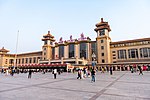Chongwenmen

Chongwenmen (Chinese: 崇文門; pinyin: Chóngwénmén; Manchu: ᡧᡠᠪᡝᠸᡝᠰᡳᡥᡠᠯᡝᡵᡝᡩᡠᡴᠠ; Möllendorff: šu be wesihulere duka) was a gate that was part of Beijing's city wall in what is now Dongcheng District. The gate stood in the southeastern part of Beijing's inner city, immediately south of the old Beijing Legation Quarter. In the 1960s, the gate and much of the wall was torn down to make room for Beijing's second ring road. Today, Chongwenmen is marked by the intersection of Chongwenmen Nei (Inner) and Chongwenmen Wai (Outer) Street, which run north-south through the former gate, Chongwenmen East and Chongwenmen West Street, which run east-west where the wall stood, and Beijing Station West Street, a diagonal street, going northwest to the Beijing railway station. Chongwenmen is a transport node in Beijing. Chongwenmen Station is an interchange station on Lines 2 and 5 of the Beijing Subway. Chongwen District, an administrative division of the city from 1952 to 2010 and now folded into Dongcheng District, was named after Chongwenmen.
Excerpt from the Wikipedia article Chongwenmen (License: CC BY-SA 3.0, Authors, Images).Chongwenmen
国瑞北路, Beijing Chongwenmenwai
Geographical coordinates (GPS) Address Nearby Places Show on map
Geographical coordinates (GPS)
| Latitude | Longitude |
|---|---|
| N 39.8982 ° | E 116.4176 ° |
Address
国瑞北路
国瑞北路
100010 Beijing, Chongwenmenwai
Beijing, China
Open on Google Maps











